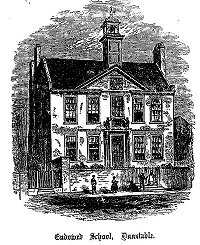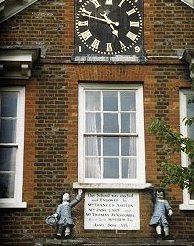Dunstable
Chew's House School
Places > Dunstable > Schools > Chews House School
Chew's House, by Hugh Garrod
First published in the Dunstable & District Local History
Society Newsletter
Issue No. 23
The Charity School 1715 to 1880
William Chew, son of Thomas, died in testate on March 18th 1712. He had intended to endow a charity school for the teaching and clothing of 40 local poor boys. This was inspired by the national movement of the time to found Charity Schools. The Anglican church and SPCK (Society for the Propagation of Christian Knowledge) encouraged this as an attempt to defuse social unrest and to counter the growing influence of the dissenting churches. Locally, there was a large Baptist congregation, based in Kensworth.
 |
 |
|
From: Charles Lamborn , |
Two lead statues of the Blue Boys in the uniform |
Queen Anne's letter (1711) encouraged the establishment of church schools to teach the Catechism. Williams sisters, Jane Cart, Frances Ashton and his nephew Thomas Aynscombe were his executers. They built Chew's House and opened the school to fulfil his intentions. It was funded by estates which produced revenue of 150 per annum. The running of the school was set out in the settlements of 1724 and 1727.
The boys were to be 7 years old, the sons of parents who were members of the Church of England and who had been in communion for two years. The master was required to take the boys to divine service at the Priory Church. If the parents refused to allow this, the boys would be expelled. The free uniform was blue and consisted of suits lined with calico, shirts of bleached linen, knitted hose and caps with scarlet bands and tassels. The school did not attract dissenters to the Church of England, rather it maintained C. of E. numbers and confirmed them in their values. The school hours in the summer were 7am to 11am and 1pm to 5pm. In the winter it opened an hour later and closed an hour earlier. The school shut in August so that the boys could earn a small amount for their families by helping to bring in the harvest.
Entry required that each boy should be able to read from the New Testament. This shows that the school was intended for the sons of what were known as 'the deserving poor'. These were hard working traders and labourers who had sufficient education or finance to be able to teach their sons to read. Some boys had their entrance delayed as their reading was not good enough. In 1775 there were nine vacancies, but only four pupils were admitted. None others qualified. Young boys were employable and potential wage earners. Sending a son to school was, therefore, a financial sacrifice. Only one boy per family was able to attend at any one time. This was a realistic rule, as no eligible family could afford to be without the income of two boys. On leaving, apprenticeships of 5 were provided. These allowed the boys to be taken on in local firms and to make the most of their education.
The 1830 Directory contains the entry 'Free School and Gent's Academy, High Street'. Between 1789 and 1880, 759 boys passed through the school. 13 died, 11 were expelled, 10 moved away, one was admitted to Christ's Hospital school in London and one joined the Wesleyan School. 245 boys left before 14, mostly to become wage earners.133 boys stayed 7 years and 66% remained till they were 14 years old. Between 1870 and 1880 this rose to 88%. Between 1868 and 1875 20 sons of widows stayed on at the school till their 14th birthdays. This implies that funds and bursaries must have been found for them. Of the 18 labourers' children who attended between 1736 and 1875, 5 became carpenters, 4 shoe makers, 2 tailors, 2 butchers, 1 cabinet maker, 1 blacksmith, 1 painter, 1 iron monger and 1 became a solicitor's clerk.
Other schools opened in the town during the 19th century. Among them were, the National School in 1838, the British School in 1843, the Wesleyan Day School in 1853 and the Ashton Elementary School in 1864. None of these was a threat to the Charity School, either in quality of education, the provision of free uniform, or in the provision of apprenticeships. From the mid 1860s, boys transferred from the newly opened Ashton Elementary School at age 8.
The Charity School was run by a board of Trustees who were nominally overseen by the Charity Commissioners. Up to 1880, the Trustees had a fairly free hand and seem to have run a successful and popular school. There was always a waiting list for places. Up to 1867 there were around 60 boys and the school was independent of the National Society. The Trustees, who were also the school Governors were answerable to the Priory Church annual vestry meeting. There were seven Trustees, mostly local men, including the Rector and Dunstable businessmen and solicitors. They were untypical Trustees in that they took good care of the land investments and the school management. The trustees met at Whitsun for an annual dinner. The schools income rose and fell with farm rents. The Masters salary was 60 pa in 1823 and 150 pa in 1880. The salary was supplemented by the admission of fee-paying scholars, both boarders and day boys.
Page last updated: 23rd January 2014
